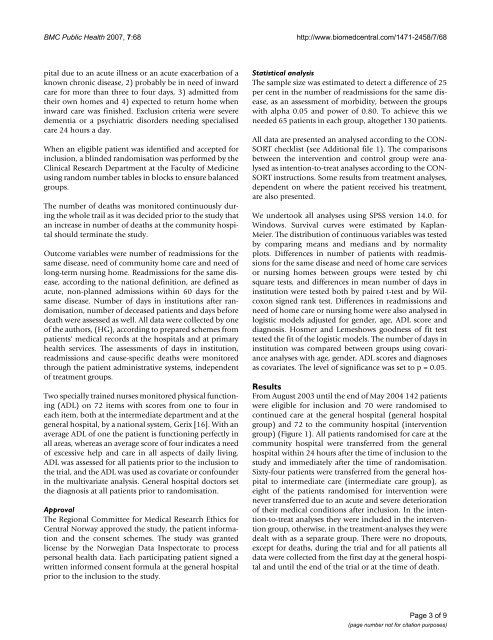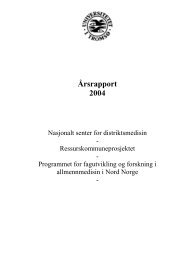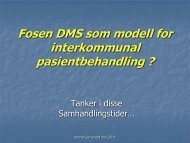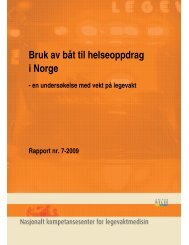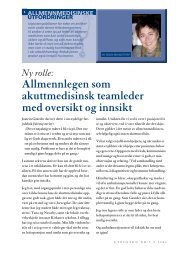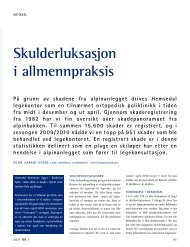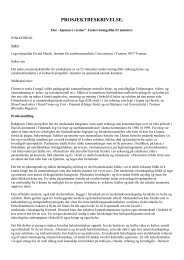Helge Garåsen The Trondheim Model - NSDM
Helge Garåsen The Trondheim Model - NSDM
Helge Garåsen The Trondheim Model - NSDM
Create successful ePaper yourself
Turn your PDF publications into a flip-book with our unique Google optimized e-Paper software.
BMC Public Health 2007, 7:68<br />
http://www.biomedcentral.com/1471-2458/7/68<br />
pital due to an acute illness or an acute exacerbation of a<br />
known chronic disease, 2) probably be in need of inward<br />
care for more than three to four days, 3) admitted from<br />
their own homes and 4) expected to return home when<br />
inward care was finished. Exclusion criteria were severe<br />
dementia or a psychiatric disorders needing specialised<br />
care 24 hours a day.<br />
When an eligible patient was identified and accepted for<br />
inclusion, a blinded randomisation was performed by the<br />
Clinical Research Department at the Faculty of Medicine<br />
using random number tables in blocks to ensure balanced<br />
groups.<br />
<strong>The</strong> number of deaths was monitored continuously during<br />
the whole trail as it was decided prior to the study that<br />
an increase in number of deaths at the community hospital<br />
should terminate the study.<br />
Outcome variables were number of readmissions for the<br />
same disease, need of community home care and need of<br />
long-term nursing home. Readmissions for the same disease,<br />
according to the national definition, are defined as<br />
acute, non-planned admissions within 60 days for the<br />
same disease. Number of days in institutions after randomisation,<br />
number of deceased patients and days before<br />
death were assessed as well. All data were collected by one<br />
of the authors, (HG), according to prepared schemes from<br />
patients' medical records at the hospitals and at primary<br />
health services. <strong>The</strong> assessments of days in institution,<br />
readmissions and cause-specific deaths were monitored<br />
through the patient administrative systems, independent<br />
of treatment groups.<br />
Two specially trained nurses monitored physical functioning<br />
(ADL) on 72 items with scores from one to four in<br />
each item, both at the intermediate department and at the<br />
general hospital, by a national system, Gerix [16]. With an<br />
average ADL of one the patient is functioning perfectly in<br />
all areas, whereas an average score of four indicates a need<br />
of excessive help and care in all aspects of daily living.<br />
ADL was assessed for all patients prior to the inclusion to<br />
the trial, and the ADL was used as covariate or confounder<br />
in the multivariate analysis. General hospital doctors set<br />
the diagnosis at all patients prior to randomisation.<br />
Approval<br />
<strong>The</strong> Regional Committee for Medical Research Ethics for<br />
Central Norway approved the study, the patient information<br />
and the consent schemes. <strong>The</strong> study was granted<br />
license by the Norwegian Data Inspectorate to process<br />
personal health data. Each participating patient signed a<br />
written informed consent formula at the general hospital<br />
prior to the inclusion to the study.<br />
Statistical analysis<br />
<strong>The</strong> sample size was estimated to detect a difference of 25<br />
per cent in the number of readmissions for the same disease,<br />
as an assessment of morbidity, between the groups<br />
with alpha 0.05 and power of 0.80. To achieve this we<br />
needed 65 patients in each group, altogether 130 patients.<br />
All data are presented an analysed according to the CON-<br />
SORT checklist (see Additional file 1). <strong>The</strong> comparisons<br />
between the intervention and control group were analysed<br />
as intention-to-treat analyses according to the CON-<br />
SORT instructions. Some results from treatment analyses,<br />
dependent on where the patient received his treatment,<br />
are also presented.<br />
We undertook all analyses using SPSS version 14.0. for<br />
Windows. Survival curves were estimated by Kaplan-<br />
Meier. <strong>The</strong> distribution of continuous variables was tested<br />
by comparing means and medians and by normality<br />
plots. Differences in number of patients with readmissions<br />
for the same disease and need of home care services<br />
or nursing homes between groups were tested by chi<br />
square tests, and differences in mean number of days in<br />
institution were tested both by paired t-test and by Wilcoxon<br />
signed rank test. Differences in readmissions and<br />
need of home care or nursing home were also analysed in<br />
logistic models adjusted for gender, age, ADL score and<br />
diagnosis. Hosmer and Lemeshows goodness of fit test<br />
tested the fit of the logistic models. <strong>The</strong> number of days in<br />
institution was compared between groups using covariance<br />
analyses with age, gender, ADL scores and diagnoses<br />
as covariates. <strong>The</strong> level of significance was set to p = 0.05.<br />
Results<br />
From August 2003 until the end of May 2004 142 patients<br />
were eligible for inclusion and 70 were randomised to<br />
continued care at the general hospital (general hospital<br />
group) and 72 to the community hospital (intervention<br />
group) (Figure 1). All patients randomised for care at the<br />
community hospital were transferred from the general<br />
hospital within 24 hours after the time of inclusion to the<br />
study and immediately after the time of randomisation.<br />
Sixty-four patients were transferred from the general hospital<br />
to intermediate care (intermediate care group), as<br />
eight of the patients randomised for intervention were<br />
never transferred due to an acute and severe deterioration<br />
of their medical conditions after inclusion. In the intention-to-treat<br />
analyses they were included in the intervention<br />
group, otherwise, in the treatment-analyses they were<br />
dealt with as a separate group. <strong>The</strong>re were no dropouts,<br />
except for deaths, during the trial and for all patients all<br />
data were collected from the first day at the general hospital<br />
and until the end of the trial or at the time of death.<br />
Page 3 of 9<br />
(page number not for citation purposes)


